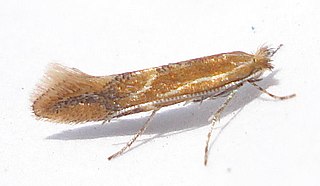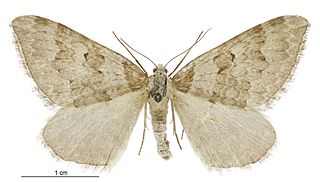
Bucculatricidae or (Bucculatrigidae) is a family of moths. This small family has representatives in all parts of the world. Some authors place the group as a subfamily of the family Lyonetiidae.

Phyllonorycter is a genus of moths in the family Gracillariidae.
Bucculatrix andalusica is a moth species in the family Bucculatricidae. It is found in southern Spain. It was first described by G. Deschka in 1980.
Bucculatrix anthemidella is a moth in the family Bucculatricidae. It is found in Kyrgyzstan and Ukraine. The species was first described by G. Deschka in 1972.
Bucculatrix armeniaca is a moth in the family Bucculatricidae. It is found in Armenia and the southern part of European Russia. The species was first described by G. Deschka in 1992.
Bucculatrix cretica is a moth in the family Bucculatricidae. It was described by G. Deschka in 1991. It is found on Crete.
Bucculatrix pannonica is a moth in the family Bucculatricidae. It was described by G. Deschka in 1982. It is found in Austria and Slovakia.
Bucculatrix ulmifoliae is a moth in the family Bucculatricidae. It was described by Erich Martin Hering in 1931. It is found in Great Britain, the Netherlands, Germany, central and eastern Europe. It has also been recorded from Iran.
Bucculatrix iranica is a moth of the family Bucculatricidae. It was described by G. Deschka in 1981 and is found in Iran.
Bucculatrix endospiralis is a moth of the family Bucculatricidae. It was described by G. Deschka in 1981. It is found in Iran and Yemen.
Bucculatrix kendalli is a moth in the family Bucculatricidae. It is found in North America, where it has been recorded from Texas. It was described by André Blanchard and Edward C. Knudson in 1985.
Bucculatrix subnitens is a moth in the family Bucculatricidae. It is found in North America, where it has been recorded from Arizona. The species was described by Thomas de Grey, 6th Baron Walsingham in 1914.
Bucculatrix ochrisuffusa is a moth in the family Bucculatricidae. It is found in North America, where it has been recorded from Ohio. It was described in 1963 by Annette Frances Braun.
Bucculatrix splendida is a moth in the family Bucculatricidae. It was described by Svetlana Seksjaeva in 1992. It is found in Japan and the Russian Far East.
Bucculatrix galinsogae is a moth in the family Bucculatricidae. It is found in Ecuador. The species was described in 2013 by G. Deschka.
Bucculatrix hagnopis is a moth in the family Bucculatricidae. It is found in India. The species was first described in 1930 by Edward Meyrick.
Bucculatrix formosa is a moth in the family Bucculatricidae. It is found in the Kugitangtau Mountains in Turkmenistan. It was described in 1992 by Rimantas Puplesis and Svetlana Seksjaeva.
Bucculatrix mirnae is a moth in the Bucculatricidae family. It is found in the Azapa Valley in northern Chile. The species was first described in 2012 by Héctor Vargas and Gilson R.P. Moreira.

Xanthorhoe frigida is a species of moth in the family Geometridae. It is endemic to New Zealand. It is classified as nationally vulnerable by the Department of Conservation.

Hierodoris polita is a species of moth in the family Oecophoridae. It is endemic to New Zealand. This species is classified as "At Risk, Naturally Uncommon" by the Department of Conservation.



